The Great Sewer
With the increase of the population of Paris, the evacuation of the waste water takes more and more importance. In the 16th century, the brook was channeled and transformed into sewer: the Grand Égout (Great Sewer). Its course was modified and lengthened, forming a large loop around the city limits. It began at the site of the present Place de la Republique, and then moved westward by the rue du Château-d'Eau, the rue des Petites-Écuries, the rue Richer, the Rue de Provence, the rue Roquépine, the rue de Penthièvre, the rue du Colisée and the rue Marbeuf and finally the Seine river where it ended, between the pont de l'Alma and the Place du Trocadéro.
In the 1760s, Jean-Joseph de Laborde covered the Great Sewer for reasons of public health. It is notably the Rue de Provence with an East-West route that covers the Great Sewer and makes disappear the small pont d'Arcans (Arcans bridge). This bridge allowed to cross the Grand Sewer at approximate level of the rue de la Chaussée-d'Antin today.
On the other hand, Jean-Joseph de Laborde obtained the right to subdivide and sell the land he owned on rue de Provence and rue d'Artois, now rue Laffitte.
Totally filled during the extension of the city, the Menilmontant brook finally disappeared completely. It is found, however, in the name of the street Passage du Ruisseau-de-Ménilmontant which means 'passage of the Menilmontant brook', located in the 20th arrondissement of Paris.
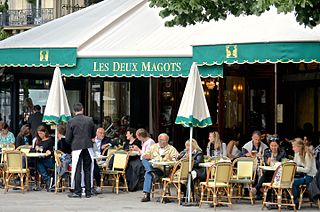
The 6th arrondissement of Paris is one of the 20 arrondissements of the capital city of France. In spoken French, this arrondissement is referred to as le sixième.
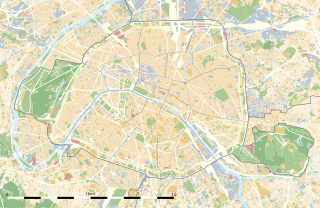
The Île de la Cité is an island in the river Seine in the center of Paris. In the 4th century, it was the site of the fortress of the Roman governor. In 508 Clovis I, the first King of the Franks, established his palace on the island. In the 12th century it became an important religious center, the home of Notre-Dame cathedral, and the royal chapel of Sainte-Chapelle, as well as the city's first hospital: the Hôtel-Dieu. It is also the site of the city's oldest surviving bridge, the Pont Neuf.

Châtelet is a station of the Paris Métro and Île-de-France's RER commuter rail service, located in the centre of medieval Paris, on the border between the 1st and 4th arrondissements. It serves RER A, RER B and RER D, as well as Line 1, Line 4, Line 7, Line 11 and Line 14 of the Paris Métro; it is the southern terminus of Line 11. The station is made up of two parts connected by a long corridor: Lines 7 and 11 under the Place du Châtelet and the Quai de Gesvre, next to the Seine; Lines 1, 4 and 14 towards Rue Saint-Denis and the Rue de Rivoli.

The sewers of the French capital Paris date back to the year 1370 when the first underground system was constructed under Rue Montmartre. Consecutive French governments enlarged the system to cover the city's population, including expansions under Louis XIV and Napoleon III, and modernisation programs in the 1990s under Mayor Jacques Chirac. The system has featured in popular culture through its existence, including Victor Hugo's 1862 novel, Les Misérables, and H. L. Humes' 1958 novel The Underground City.

Haussmann's renovation of Paris was a vast public works programme commissioned by Emperor Napoleon III and directed by his prefect of Seine, Georges-Eugène Haussmann, between 1853 and 1870. It included the demolition of medieval neighbourhoods that were deemed overcrowded and unhealthy by officials at the time; the building of wide avenues; new parks and squares; the annexation of the suburbs surrounding Paris; and the construction of new sewers, fountains and aqueducts. Haussmann's work was met with fierce opposition, and he was finally dismissed by Napoleon III in 1870; but work on his projects continued until 1927. The street plan and distinctive appearance of the centre of Paris today are largely the result of Haussmann's renovation.

This "quartier" of Paris got its name from the rue de la Chaussée-d'Antin in the 9th arrondissement of Paris. It runs north-northwest from the Boulevard des Italiens to the Église de la Sainte-Trinité.

Jean Benoît Vincent Barré was a French architect. He was one of the most important architects of the 18th century and one of the creators of the 'Louis XVI style' of architecture.
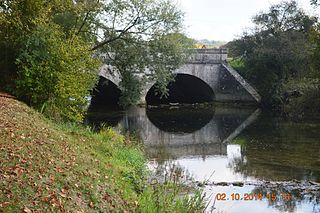
Aisey-sur-Seine is a commune in the Côte-d'Or department in the Bourgogne-Franche-Comté region of eastern France.
The Pont Royal is a bridge crossing the river Seine in Paris. It is the third oldest bridge in Paris, after the Pont Neuf and the Pont Marie.

Rue du Bac is a street in Paris situated in the 7th arrondissement. The street, which is 1150 m long, begins at the junction of the quais Voltaire and Anatole-France and ends at the rue de Sèvres.
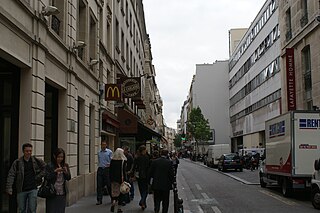
The rue de Provence is a street located in the 8th and 9th Arrondissements of Paris. It begins at the rue du Faubourg Montmartre and ends at the rue de Rome. Only the short part of the street between rue du Havre and rue de Rome is in the 8th arrondissement.

The Bassin de la Villette is the largest artificial lake in Paris. It was filled with water on 2 December 1808. Located in the 19th arrondissement of the capital, it links the Canal de l'Ourcq to the Canal Saint-Martin, and it represents one of the elements of the Réseau des Canaux Parisiens, a public-works authority operated by the city. The other components of the network are the Canal de l'Ourcq, the Canal Saint-Denis, the Canal Saint-Martin, and the Bassin de l'Arsenal. Together, these canals and basins extend roughly 130 kilometres (81 mi).

The Grand Châtelet was a stronghold in Ancien Régime Paris, on the right bank of the Seine, on the site of what is now the Place du Châtelet; it contained a court and police headquarters and a number of prisons.

Sèvres is a commune in the southwestern suburbs of Paris, France. It is located 9.9 kilometres from the centre of Paris, in the Hauts-de-Seine department, Île-de-France region. The commune, which had a population of 23,251 as of 2018, is known for its famous porcelain production at the Manufacture nationale de Sèvres, which was also where the Treaty of Sèvres (1920) was signed.
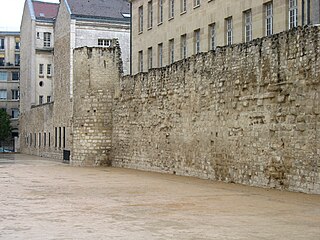
The Wall of Philip Augustus is the oldest city wall of Paris (France) whose plan is accurately known. Partially integrated into buildings, more traces of it remain than of the later fortifications.

Louis Bernard Bonnier was a French architect known for his work as an urban planner for the city of Paris. He was instrumental in loosening the restrictions on the appearance of buildings in Paris, which resulted in the blossoming of Art Nouveau buildings. He designed many significant buildings himself, including private villas, public housing and railway buildings. In all his work he was true to the rationalist principles of Art Nouveau.

Jean Hupeau was a French architect and engineer best known for building the George V Bridge in Orleans.
This page is based on this
Wikipedia article Text is available under the
CC BY-SA 4.0 license; additional terms may apply.
Images, videos and audio are available under their respective licenses.


















